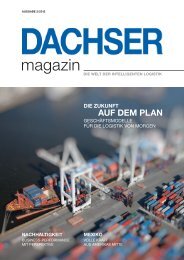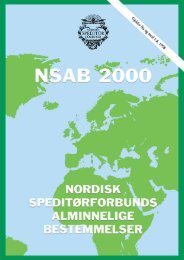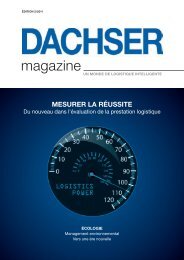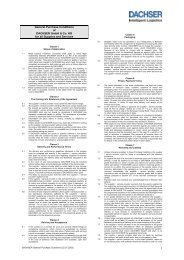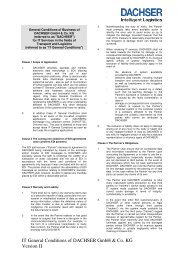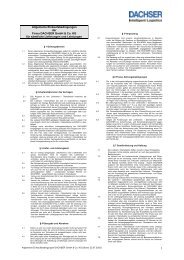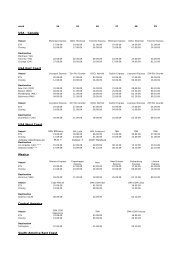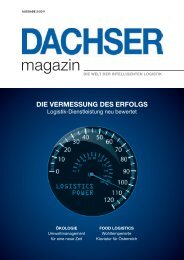NETWORKERS - dachser.sk
NETWORKERS - dachser.sk
NETWORKERS - dachser.sk
You also want an ePaper? Increase the reach of your titles
YUMPU automatically turns print PDFs into web optimized ePapers that Google loves.
Finn Skovbo Pedersen,<br />
managing director of<br />
Dachser Nordic A/S<br />
“Many major companies see this as a way<br />
of making their logistics processes leaner and<br />
concentrating them at a single point.” The<br />
consequence, he says, is that major Dachser<br />
customers with Europe-wide operations<br />
have fewer and fewer logistics managers in<br />
each individual country. “These customers<br />
are looking for logistics providers with pan-<br />
European networks.”<br />
Thinking outside the box<br />
In Denmark, one of the first network integration<br />
steps taken was the introduction of<br />
Dachser’s proprietary Domino transport<br />
management system, which is used in 17<br />
European countries and offers a high level<br />
of security and reliability. This makes communication<br />
problems between different systems<br />
a thing of the past. Another advantage<br />
is that Domino offers customers transparency<br />
from collection right through to shipment<br />
delivery. “Our employees had to completely<br />
change their way of thinking,” Pedersen says.<br />
Today, Dachser Denmark works according<br />
to exactly the same standards as the rest of the<br />
group. Whereas in the past Haugsted collected<br />
goods twice a week from each of its<br />
50 partners, they suddenly had to cope with<br />
a completely different line management.<br />
That had consequences. Haugsted’s partner<br />
network collapsed. Almost overnight, the<br />
50 partners had become competitors, because<br />
Dachser’s European network took over their<br />
ta<strong>sk</strong>s.<br />
The customer profile also changed radically.<br />
The Danes parted from customers in the<br />
field of long steel goods, which had been<br />
combined with Haugsted’s consolidated<br />
freight services. “It no longer fits in with<br />
Dachser’s groupage system,” Pedersen says.<br />
Haugsted’s export business also used to be<br />
weakly positioned. Today, Dachser Denmark<br />
delivers palletized goods for final customers<br />
to, among others, DIY stores across Europe.<br />
Famous Danish durable goods designer<br />
brands such as Bodom, Menu or prestigious<br />
Our employees had<br />
hh to completely change their<br />
way of thinking Finn Skovbo Pedersen<br />
Royal Copenhagen porcelain are transported<br />
by Dachser Europe-wide to the point of<br />
sale. Around one quarter of all Dachser<br />
Denmark’s deliveries are destined for Sweden<br />
and Norway. Many of the shipments are<br />
made up of Danfoss heating thermostats<br />
that are supplied to France and Spain.<br />
Five years after the extensive integration<br />
process, Pedersen takes stock: Dachser<br />
Denmark has meanwhile managed to build<br />
up a national network on a scale that hadn’t<br />
existed previously. Although a few of the<br />
238 staff members left the company in the<br />
early days, the workforce has in the meantime<br />
grown to 320. Two years ago, a terminal with<br />
an area of 4,300 square metres and 43 loading<br />
bays was opened in Kolding, Denmark –<br />
already a Dachser location before the integration.<br />
While five years ago the facility handled<br />
13,000 consignments per month, in the<br />
meantime that volume has jumped to 36,000.<br />
Moreover, in September a new terminal with<br />
an area of 4,200 square metres and 41 bays<br />
was inaugurated in Copenhagen. Here, too,<br />
the number of monthly consignments has<br />
risen from 8,000 five years ago to around<br />
27,000 today. In addition to Dachser Nordic’s<br />
administrative departments, the 3,000 square<br />
metres of office space also accommodates<br />
the Air & Sea Logistics business segment.<br />
And: “In terms of customer satisfaction, we<br />
are out there with the best,” Pedersen says<br />
enthusiastically.<br />
A favourable position<br />
with customers<br />
The standards practised at Dachser in Denmark<br />
since 2005 apply across the entire<br />
pan-European network – in the meantime<br />
28 countries including Serbia, Bosnia and<br />
Bulgaria. Three Eurohubs represent important<br />
nerve centres within the network from<br />
where markets in central, western and eastern<br />
Europe are served: in Überherrn/Germany<br />
since 2002, in Bratislava since 2008 and from<br />
July 2011 in Clermont-Ferrand/France (see<br />
COVER STORY<br />
On route to Europe: integration brings<br />
markets closer together<br />
also page 7). Dachser also operates 129 terminals<br />
of its own, as well as 101 partner locations<br />
in Europe, for example the family-run<br />
company Azkar in Spain and Fercam with<br />
more than 30 locations in Italy.<br />
“We have almost 6,000 of our own swap<br />
bodies and over 1,000 of our own trailers in<br />
operation across Europe,” Janda says, explaining<br />
further strengths of the pan-European<br />
network. Thanks to double-deck loading,<br />
the box vehicles provide a high degree of<br />
load security. This was one more reason that<br />
convinced the Danish family enterprise,<br />
Haugsted, to opt for integration into<br />
Dachser’s extensive European network and at<br />
the same time for a new entrepreneurial environment,<br />
thus paving the way to a positive<br />
future. “With increasing Europeanization<br />
and globalization,” says logistics expert Professor<br />
Peter Klaus, “companies able to offer<br />
high-quality and efficient international services<br />
without a doubt have greater development<br />
potential.” S. Machens<br />
DACHSER magazine 19



